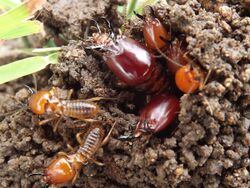Biology:Macrotermes michaelseni
| Macrotermes michaelseni | |
|---|---|

| |
| Scientific classification | |
| Domain: | Eukaryota |
| Kingdom: | Animalia |
| Phylum: | Arthropoda |
| Class: | Insecta |
| Order: | Blattodea |
| Infraorder: | Isoptera |
| Family: | Termitidae |
| Genus: | Macrotermes |
| Species: | M. michaelseni
|
| Binomial name | |
| Macrotermes michaelseni (Sjöstedt, 1914)
| |
| Synonyms[1][2] | |
| |
Macrotermes michaelseni is a species of termite in the family Termitidae, found in sub-Saharan Africa. It is associated with the fungus Termitomyces schimperi.[3]
Distribution and habitat
M. michaelseni is one of a number of Macrotermes species occurring in savannahs in sub-Saharan Africa. These species vary in their different soil preferences, some preferring moist habitats, with M. michaelseni being tolerant of drier habitats than the others. It is common in the Okavango Delta in northern Botswana, an area that sees periodic flooding from summer rains in the catchment area; clay soils and high groundwater levels are favourable to it, and there are up to six mounds per hectare in the delta area.[3]
Colony structure
A M. michaelseni nest initially consists of a number of chambers and tunnels completely underground. A mound is built above the ground only in a mature colony, and in time becomes an enormous structure, with ridges, pinnacles and chimneys,[4] up to 4 m (13 ft) tall covering an area of up to 50 m2 (540 sq ft). Below the surface of the ground is an extensive network of chambers and foraging passageways. Apart from the sealed mound, with its air passages, the colony lives largely underground, the workers using the foraging tunnels to access feeding areas and carry the food they collect back to the nest.[3]
Ecology
The termite workers forage at night, gathering dead grass, grass litter and woody litter. In savannah woodland, leaves from Croton megalocarpus, Philenoptera violacea, Vachellia erioloba and Colophospermum mopane forms the bulk of the leaf litter collected, with elephant dung being favoured at the end of the dry season. The vegetation is carried back to the nest along the foraging passageways both day and night, where it is chewed up by younger workers. They mould their faeces and deposit them on a comb structure on which fungi grow.[3] When the comb is eaten by the termites, the fungal spores pass through their gut to complete the cycle by germinating in the fresh faecal pellets.[5]
The fungus which is associated with M. michaelseni is Termitomyces schimperi. The fruiting bodies, with their large, white, scaly caps, are found growing above ground at the base of the termite mound. They appear after heavy rain, and reappear annually beside the same mound, the hyphae extending down to the termite nest beneath the ground.[2]
In the Okavango Delta, M. michaelseni is considered to be an ecosystem engineer.[3] A mature colony may contain over a million termites including nymphs, workers and soldiers. Material is collected from a radius of fifty metres or more around the nest and brought to a central location where nutrients are thus concentrated. Clay particles are also collected for mound-building, and the area close to the mound is gradually raised slightly above the surrounding flat land. The delta is subject to occasional flooding, and when this happens, the mounds and their low islands project above the surface of the water. The colony of termites below may be killed, but there is a tendency for new colonies to become established at the same location. The mounds are a favourable habitat for herbs and woody plants to grow, with their associated invertebrates and other animals, and biodiversity increases.[3]
References
- ↑ Bignell, David Edward; Roisin, Yves; Lo, Nathan (2010). Biology of Termites: a Modern Synthesis. Springer. pp. 358–360. ISBN 9789048139774.
- ↑ 2.0 2.1 van der Westhuizen, G.C.A.; Eicker, A. (February 1991). "The 'Omajowa' or 'Termitenpilz', Termitomyces sp. (Agaricales) of Namibia". South African Journal of Botany 57 (1): 67–70. doi:10.1016/S0254-6299(16)30986-3.
- ↑ 3.0 3.1 3.2 3.3 3.4 3.5 Dangerfield, J.M.; Mccarthy, T.S.; Ellery, W.N. (1998-07-01). "The mound-building termite Macrotermes michaelseni as an ecosystem engineer". Journal of Tropical Ecology 14 (4): 507–520. doi:10.1017/s0266467498000364. ISSN 1469-7831. https://www.researchgate.net/publication/201996995.
- ↑ Krishna, K.. "Termite". Encyclopædia Britannica. http://www.britannica.com/animal/termite. Retrieved 14 May 2021.
- ↑ Aanen, D.K.; Eggleton, P.; Rouland-Lefevre, C.; Guldberg-Froslev, T.; Rosendahl, S.; Boomsma, J.J. (2002). "The evolution of fungus-growing termites and their mutualistic fungal symbionts". Proceedings of the National Academy of Sciences 99 (23): 14887–14892. doi:10.1073/pnas.222313099. PMID 12386341. Bibcode: 2002PNAS...9914887A.
Wikidata ☰ Q20919345 entry
 |

